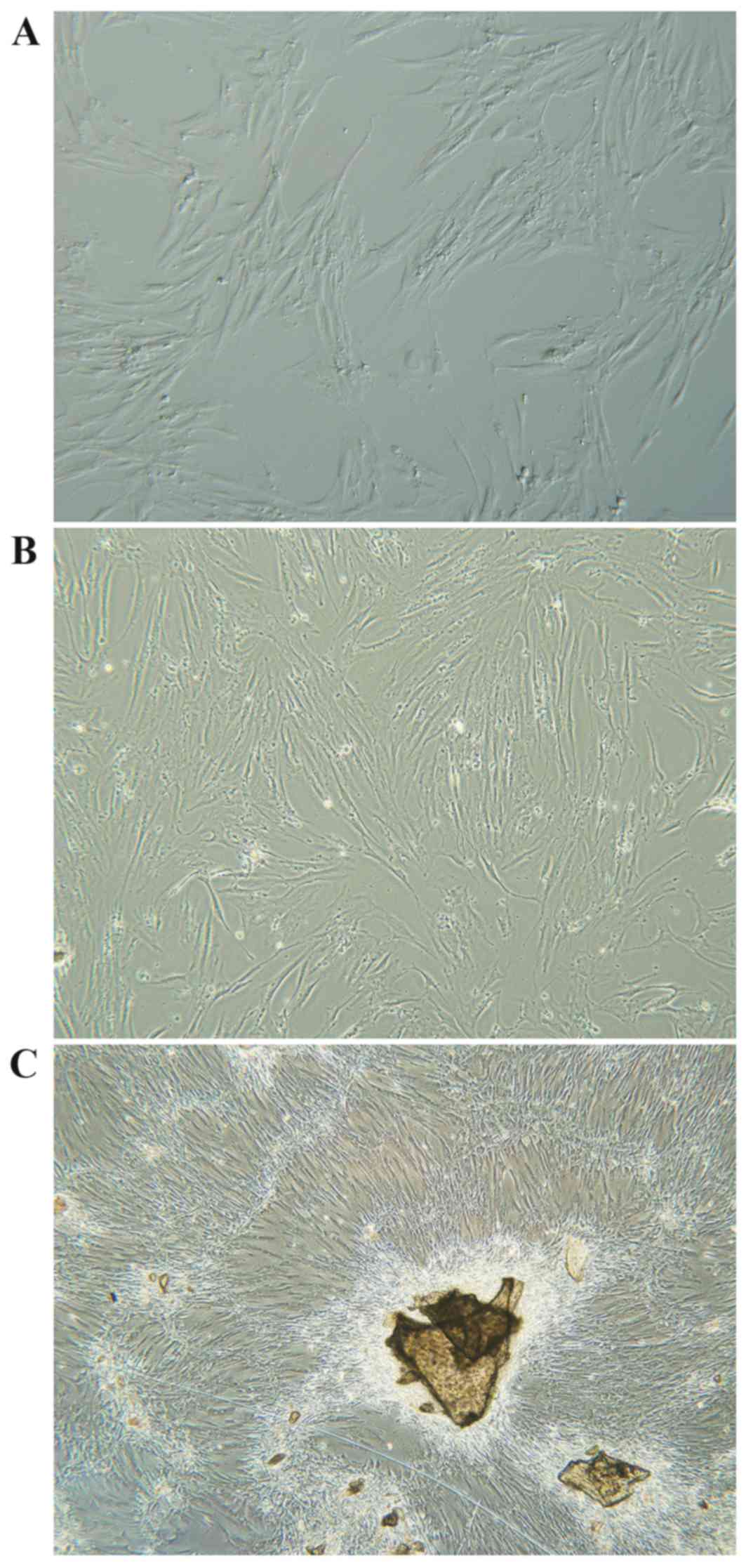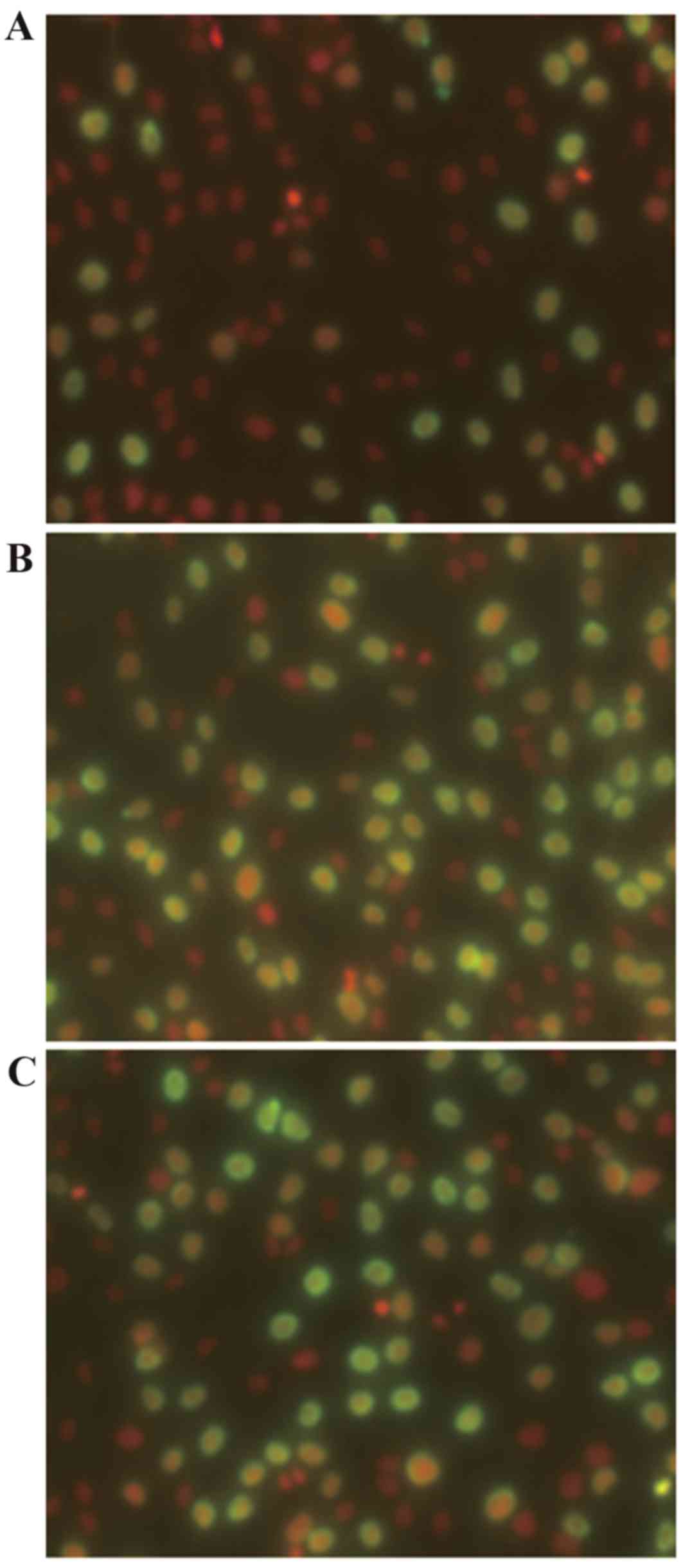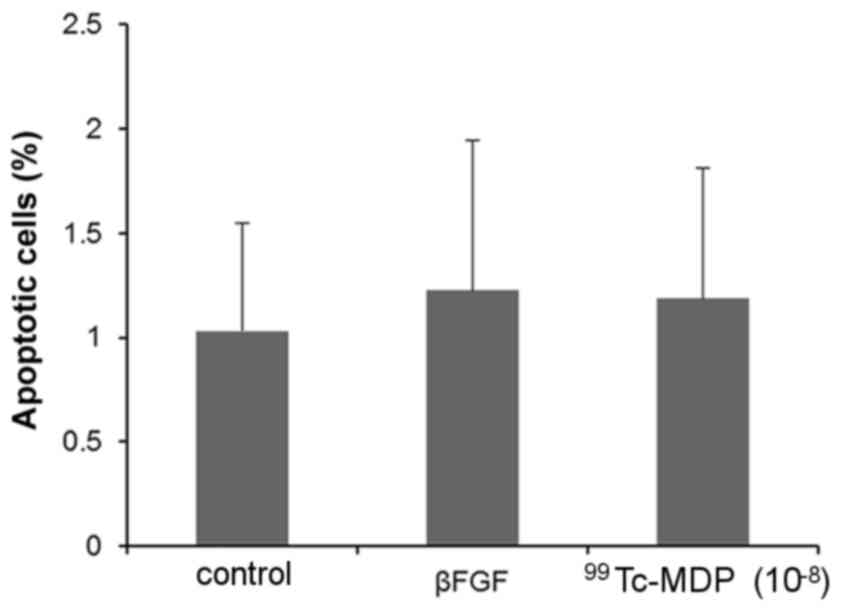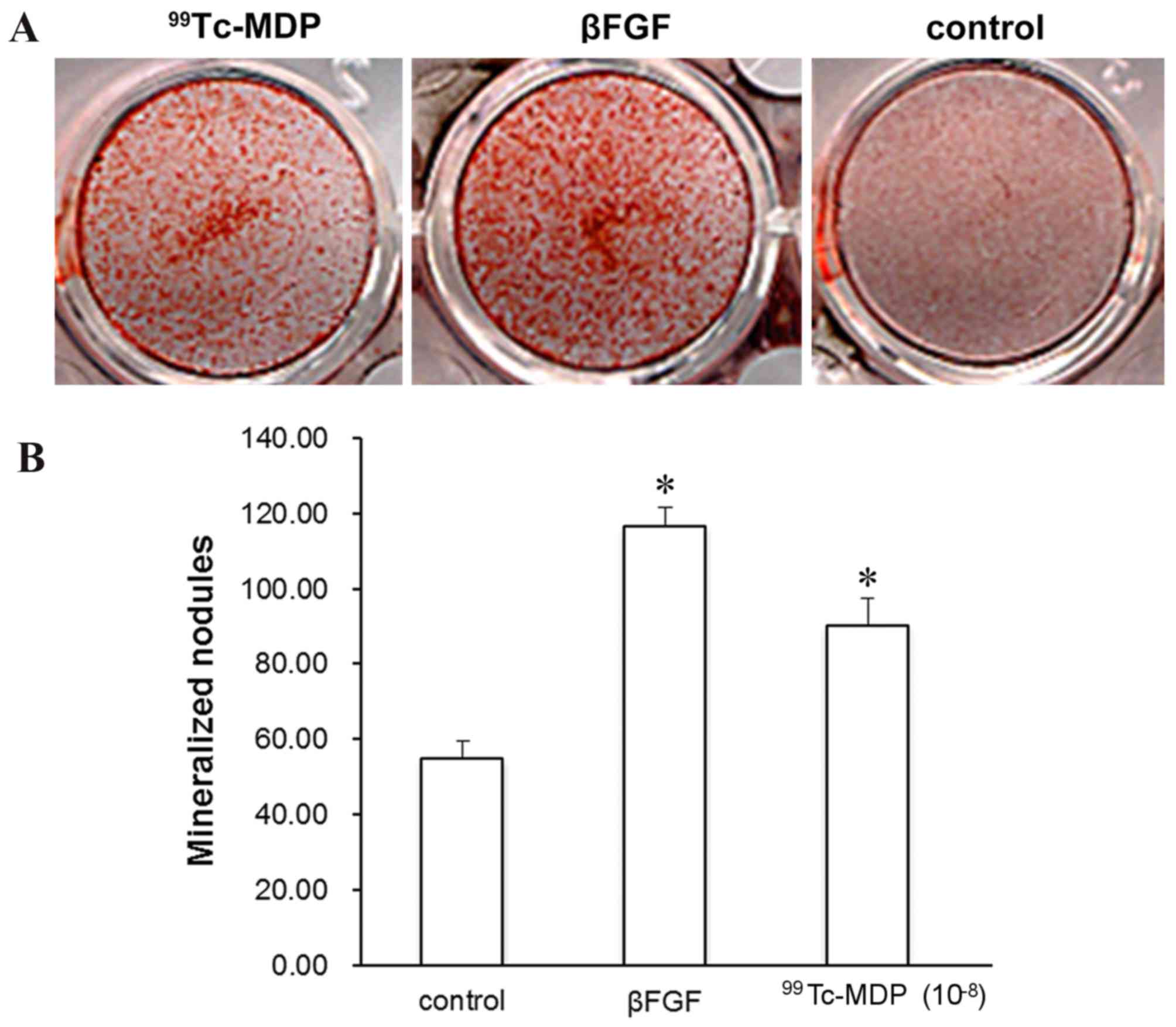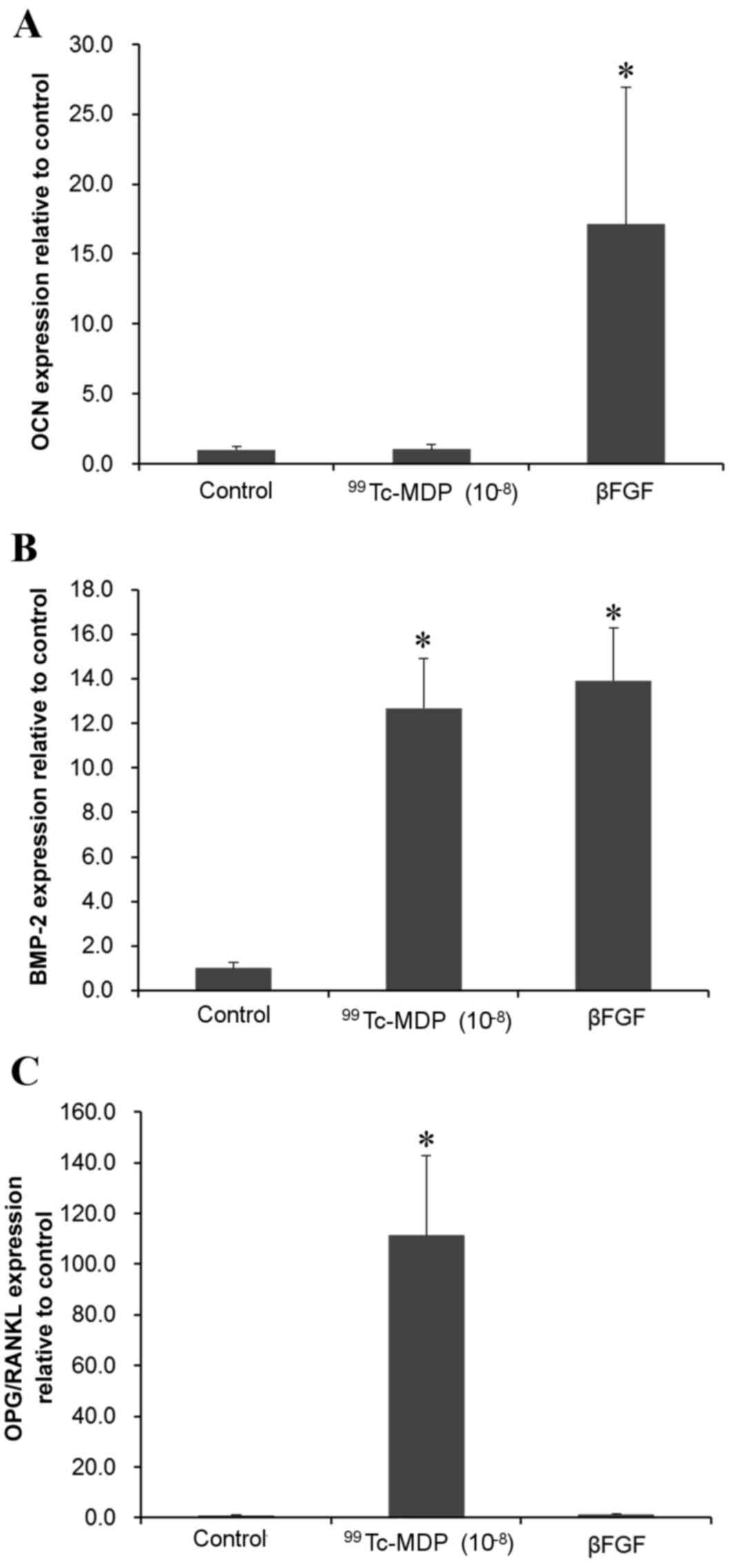99Tc-MDP-induced human osteoblast proliferation, differentiation and expression of osteoprotegerin
- Authors:
- Published online on: June 22, 2017 https://doi.org/10.3892/mmr.2017.6839
- Pages: 1801-1809
-
Copyright: © Chen et al. This is an open access article distributed under the terms of Creative Commons Attribution License.
Abstract
Introduction
The metabolism of bone tissues, also known as bone remodeling, is a cyclic process involving constant resorption of old bone by osteoclasts and formation of new bone by osteoblasts. Overactive bone resorption or dysfunction of bone formation perturbs the balance between bone resorption and formation, damaging the structural integrity and strength of bone, resulting in the loss of structural integrity and bone mass, manifesting as osteoporosis (1). An imbalance between osteoclast and osteoblast activity is also involved in the pathogenesis of common rheumatic diseases, including rheumatoid arthritis (RA), ankylosing spondylitis (AS), osteoarthritis and osteoporosis (1). Thus, one of the targets for treating these diseases is to restore this balance and prevent bone destruction by inhibiting osteoclast or inducing osteoblast functions.
Osteoblasts differentiate from bone marrow stromal cells. The process of osteoblast differentiation consists of 3 steps: Cell proliferation, extracellular matrix formation and maturation, and bone matrix mineralization (2). Each differentiation period involves the expression and regulation of distinct genes. During osteoblast proliferation, the expression of type I collagen peaks, facilitating bone matrix maturation and mineralization. During bone matrix maturation, osteoblast proliferation is reduced and expression of alkaline phosphatase (ALP) increases. The peak of ALP activity marks the maturation of the bone matrix. During bone matrix mineralization, ALP activity decreases while osteocalcin (OCN) expression increases, and the formation of bone nodules indicates bone matrix mineralization (3). Bone morphogenetic protein-2 (BMP-2) is the only cytokine that can independently induce ectopic bone formation. BMP-2 has been reported to be involved in the induction of pluripotent stem cell differentiation into bone cells, and is associated with multiple signal pathways that promote osteogenesis (4).
During bone formation, cytokines synthesized and secreted by osteoblasts regulate the differentiation and maturation of osteoclasts (5). The osteoprotegerin (OPG)/receptor activator of nuclear factor-κB (NF-κB; RANK)/receptor activator of NF-κB ligand (RANKL) system has been reported to regulate osteoclast function and bone remodeling (6). RANKL secreted by osteoblasts and bone marrow stromal cells binds to RANK expressed on the surface of osteoclast precursor cells or osteoclasts, inducing osteoclast differentiation and increasing bone resorption. OPG secreted by osteoblasts and bone marrow stromal cells competitively binds to RANKL, inhibiting RANKL and RANK binding. Thus, the balance of OPG and RANKL expression regulates osteoclast differentiation, activation and function (6). RANKL expression and soluble RANKL (sRANKL) release induce bone resorption and destruction (7). OPG and RANKL expression regulates osteoclast activation, and this further influences bone remodeling (8).
The major component of technetium methylenediphosphonate (99Tc-MDP) injection is the chelate of stannous chloride-reduced technetium (agent A) with methylene diphosphonate (agent B). 99Tc-MDP is widely used in the treatment of many diseases, including RA, AS, osteonecrosis, osteoarthritis, osteoporosis, Graves' eye disease, psoriatic arthritis, bone metastases and multiple myeloma (9–12). However, previous studies have also reported additional pharmacological effects of 99Tc-MDP, including inhibition of inflammatory reactions, immune regulation and regulation of bone metabolism (11,13–15). As the synovial membrane is semi-permeable, generic drugs cannot penetrate it, but MDP is able to carry 99Tc into the joint cavity and facilitate its function close to the lesion. When 99Tc-MDP enters the joint cavity and reaches an area of synovitis or abnormal bone, it binds immature collagen or is absorbed by hydroxyapatite crystals, thereby persisting and exerting a long-lasting therapeutic effect.
However, the mechanism by which 99Tc-MDP influences bone metabolism has not been elucidated, and to the best of our knowledge, no study has reported the effect of 99Tc-MDP on the proliferation and function of osteoblasts cultured in vitro. The aim of the present study was to investigate the effect of 99Tc-MDP on in vitro-cultured osteoblasts, and to explore the mechanisms responsible for its inhibition of bone destruction, providing a theoretical basis for the use of 99Tc-MDP in the treatment of bone-destructive diseases.
Materials and methods
Isolation and culture of human osteoblasts
Iliac cancellous bone was sampled from 8 patients aged between 30 and 50 years, presenting with no metabolic bone diseases but receiving autologous bone transplantation to repair fracture in the West China Hospital of Sichuan University (Chengdu, China). The present study was been approved by the ethics committee of the West China Hospital of Sichuan University (Chengdu, China) and all patients gave their informed consent.
Iliac cancellous bone samples were stripped of periosteum and soft tissues, washed with sterilized phosphate buffered saline (PBS) 3 times, cut into 1 mm2 sections, washed in Dulbecco's modified Eagle's medium (DMEM; Thermo Fisher Scientific, Inc., Waltham, MA, USA) and PBS and incubated at 37°C for 8 min with erythrocyte lysate (840 mg NaHCO3, 37.2 mg EDTA, 8.023 g ammonia chloride, 1000 ml distilled water; pH 7.2). The suspension was subsequently centrifuged at 500 × g for 10 min at room temperature, and the precipitate was rinsed until it appeared white. The precipitate was pre-digested in 0.25% EDTA containing trypsin (HyClone; GE Healthcare Life Sciences, Chalfont, UK) for 20 min at 37°C. Digestion was terminated with fetal bovine serum (FBS; Yuanheng Jinma Biotechnology Co., Ltd., Beijing, China), and the supernatant was discarded. Type I collagenase (0.1%; BD Biosciences, Franklin Lakes, NJ, USA) was added at a volume ratio of 1:8, and bone cells were digested for 1 h at 37°C. Bone cells were then centrifuged at 500 × g for 5 min at room temperature and rinsed in PBS twice, then resuspended in high-glucose DMEM containing 10% FBS and antibiotics (penicillin 100 IU/ml, streptomycin 100 mg/ml) (Gibco; Thermo Fisher Scientific, Inc.) and passed through a 200-mesh stainless steel screen (75 µm pore size) to remove non-osteoblasts and impurities. The filtered suspension was further digested by type I collagenase 3 times. The cell suspension was counted using a hemocytometer and trypan blue staining. Cells were ≥95% viable and cultured at 5×104 cells/ml in a sterile Petri dish at 37°C with 5% CO2 and 95% humidity. The medium was changed every 48 h and cells were passaged with a 1:2 division using 0.25% trypsin/0.02% EDTA.
Preparation of 99Tc-MDP and β fibroblast growth factor (β-FGF) working solutions
99Tc-MDP (Chengdu Yunke Pharmaceutical Co., Ltd., Chengdu, China) was prepared according to the manufacturer's protocol. Agent A (5 ml, containing 0.05 µg of 99Tc) and B (containing 5 mg MDP and 0.5 mg stannous chloride) were mixed at room temperature for 5 min. The stock solution was then adjusted to 1 ml/mg MDP. The working solutions were freshly prepared prior to use. β-FGF (PeproTech, Inc., Rocky Hill, NJ, USA) was diluted in complete medium (high-glucose DMEM supplemented with 10% FBS and antibiotics) to 10 ng/ml.
CCK-8 measurement of cell proliferation
Passage 2 osteoblasts were cultured at 2.5×103 cells/well in a 96-well plate for 24 h. Osteoblasts were subsequently synchronized by serum starvation (24 h in DMEM containing 0.1% FBS), then incubated with medium supplemented with 10−4-10−12 M 99Tc-MDP, 10 ng/ml β-FGF or medium alone. Each condition was replicated five times. Proliferation was measured at 24, 48 and 72 h with a CCK-8 kit (Dojindo Molecular Technologies, Inc., Kumamoto, Japan), according to the manufacturer's protocol.
Bromodeoxyuridine (BrdU) measurement of cell proliferation
Passage 2 osteoblasts were cultured at 1×104 cells/well in a 24-well plate pre-covered with coverslips for 24 h. Osteoblasts were subsequently synchronized as previously described, then incubated with 10−8 M 99Tc-MDP, 10 ng/ml β-FGF or medium (high-glucose DMEM supplemented with 10% FBS and antibiotics) alone for 72 h. Each condition was replicated three times. The medium was then aspirated and 10 µg/ml BrdU (Sigma-Aldrich; Merck Millipore, Darmstadt, Germany) was added for 4 h. The slides were then washed with PBS, fixed in 4% paraformaldehyde at 4°C for 30 min, then washed with 0.1 M PBS containing 1% Triton X-100 (Amresco, Inc., Framingham, MA, USA), incubated in 1 M ice-cold HCl for 10 min, then 2 M HCl for 10 min at room temperature and incubated at 37°C for 20 min. Slides were then washed with PBS, incubated in 0.1 M sodium borate (pH=8.6) at room temperature for 12 min, washed in 0.1 M PBS containing 1% Triton X-100 and blocked in 5% FBS containing 1 M glycine for 1 h. Slides were incubated with mouse anti-BrdU immunoglobulin G (IgG; Santa Cruz Biotechnology, Inc., Dallas, TX, USA; catalog no. sc-70443; 1:100) and RNase (Ambion; Thermo Fisher Scientific, Inc.) at 4°C overnight, then washed in 0.1 M PBS containing 1% Triton X-100, and incubated with Cy3 goat-anti-mouse IgG (Jackson ImmunoResearch Laboratories, Inc., West Grove, PA, USA; catalog no. 115-165-205; 1:200) at 37°C or room temperature for 1 h, then washed in PBS and mounted with antifade medium (Thermo Fisher Scientific, Inc. P36934). The sections were preserved at 4°C in the dark, and the proportion of BrdU-positive cells was calculated by counting 10 randomly selected fields under a fluorescence microscope, at ×200 magnification.
Flow cytometric analysis of cell cycle and apoptosis
Passage 2 osteoblasts were cultured at 4×105 cells/dish in 100 mm dishes for 24 h. Osteoblasts were then synchronized and incubated with 10−8 M 99Tc-MDP, 10 ng/ml β-FGF or medium (high-glucose DMEM supplemented with 10% FBS and antibiotics) alone for 48 h. Each condition was replicated three times. Cells were then digested with trypsin, washed with PBS and collected by centrifuging at 500 × g for 5 min at room temperature. Pre-cooled ethanol (70%, 1 ml) was added to the precipitate and the cell suspension was fixed at 4°C overnight. Following centrifugation at 500 × g for 5 min at room temperature, the precipitate was resuspended in 3 ml PBS, passed through a 400-mesh screen and stained with 1 ml propidium iodide (PI) at 4°C for 30 min in the dark. The cell cycle was assessed by flow cytometry, and 3×104 cells were collected for each sample. Modfit software Version 4.0 (Verity Software House, Inc., Topsham, ME, USA) was used for data acquisition, processing, calculation of apoptotic cell proportion, and the determination of cell cycle distribution. The S-phase fraction (SPF) and proliferation index [proliferation index=(S + G2/M)/(G0/G1 + S + G2/M) ×100%] were used to evaluate the speed of proliferation.
Determination of alkaline phosphatase activity
Passage 2 osteoblasts were cultured at 5×104 cells/well in 12-well plates for 24 h. Osteoblasts were then synchronized and incubated with 10−4-10−12 M 99Tc-MDP, 10 ng/ml β-FGF or medium (high-glucose DMEM supplemented with 10% FBS and antibiotics) alone. Each condition was replicated three times. Medium was changed every 48 h, and cells were collected 3, 6 and 9 days later, washed in PBS and treated with 80 µl of lysate (50 mM Tris-HCL; pH 7.4; 150 mM NaCl, 1% TritonX-100, 0.5% sodium deoxycholate, 0.1% SDS; stored in the dark at 4°C) at 4°C for 30 min, then centrifuged at 5,000 × g at 4°C for 30 min. The supernatant was collected and 30 µl was added to each well of a 96-well plate. ALP activity was determined using the p-nitrophenyl phosphate (pNPP) method, with Alkaline Phosphatase Assay Kit (Beyotime Institute of Biotechnology, Haimen, China; P0321), according to the manufacturer's protocol; optical density at 520 nm was measured using a BioTek Synergy micro-plate reader (Thermo Fisher Scientific, Inc.). Protein content was quantified using the Thermo Scientific™ Pierce™ Coomassie Plus™ (Bradford) Protein Assay (Thermo Fisher Scientific, Inc.) (16).
Mineralized nodule counts
Passage 2 osteoblasts were cultured at 1×104 cells/well in 24-well plates for 24 h. Osteoblasts were then synchronized and incubated with 10−8 M 99Tc-MDP, 10 ng/ml β-FGF or medium (high-glucose DMEM supplemented with 10% FBS and antibiotics) alone. Each condition was replicated three times. Medium was changed every 48 h, and at 14 days complete medium containing 10 mM β-glycerophosphate and 50 mg/l ascorbic acid was added. Cells were subsequently washed in PBS, fixed with 2.5% glutaraldehyde at room temperature for 15 min, rinsed in PBS (pH 4.2), incubated with 2% Alizarin Red at 37°C for 10 min, and washed in PBS (pH 4.2). Using a polyester film with 0.2 mm2 grid marks to assist counting, red mineralized nodules >200 µm with a clear boundary were counted in 10 randomly selected high power fields under a light microscope (x40 magnification) by two independent investigators blinded to the grouping.
Reverse transcription-quantitative polymerase chain reaction (RT-PCR)
Passage 2 osteoblasts were cultured at 1×105 cells/well in a 6-well plate for 24 h. Osteoblasts were subsequently synchronized and incubated with 10−8 M 99Tc-MDP, 10 ng/ml β-FGF or medium (high-glucose DMEM supplemented with 10% FBS and antibiotics) alone for 72 h. Each condition was replicated three times. Total RNA extraction was performed using TRIzol reagent (Invitrogen; Thermo Fisher Scientific, Inc.). Total RNA (1 µg) was then reverse transcribed into cDNA (20 µl reaction volume) using First Strand cDNA Synthesis Kit (Fermentas; Thermo Fisher Scientific, Inc.) as previously described (17). Glyceraldehyde 3-phosphate dehydrogenase (GAPDH) was used as an internal reference. Forward and reverse primers of OCN, BMP-2, OPG, RANKL and GAPDH are listed in Table I. Primers were designed by Primer Premier 5.0 (PREMIER Biosoft, Palo Alto, CA, USA) and synthesized by Sangon Biotech Co., Ltd. (Shanghai, China). SYBR Green I (Takara Bio, Inc., Otsu, Japan) was used for fluorescent detection according to the manufacturer's protocol. The thermocycler conditions used were as follows: 94°C pre-denaturation for 120 sec, 94°C denaturation for 20 sec, annealing at 58, 54, 54, 54 and 50°C for OCN, BMP-2, OPG, RANKL and GAPDH, respectively, for 20 sec, 72°C elongation for 40 sec, and 45 cycles. The melting curve was plotted to determine the specificity of amplified products. Relative OCN, BMP-2, OPG, RANKL and GAPDH mRNA expression levels were determined using the 2−ΔΔCq method (18).
ELISA
Passage 2 osteoblasts were cultured at 1×105 cells/well in a 6-well plate for 24 h. Osteoblasts were then synchronized and incubated with 10−8 M 99Tc-MDP, 10 ng/ml β-FGF or medium (high-glucose DMEM supplemented with 10% FBS and antibiotics) alone for 72 h. Each condition was replicated three times. The OPG and RANKL contents in supernatants were assessed by specific ELISA kits (Cusabio Biotech Co., Ltd., College Park, MD, USA; catalog nos. CSB-E04692 h and CSB-E05125 h, respectively) was performed according to the manufacturer's protocol.
Statistical analysis
Data are expressed as the mean ± standard deviation. Statistical analysis was performed using SPSS 16.0 software (SPSS, Inc., Chicago, IL, USA). Multiple sets of data were compared by one-way analysis of variance (ANOVA). If H0 was refused, the Least Significant Difference-t test was used for multiple comparisons. Different conditions were compared by ANOVA with Dunnett's t-test and comparisons of level data were made by the rank sum test. Test level α (bilateral) was defined at 0.05, and P<0.05 was considered to indicate a statistically significant difference.
Results
Osteoblast culturing
Primary human osteoblasts were isolated from iliac cancellous bone and cultured ex vivo. Following isolation, cells were spherical, evenly distributed, and surrounded by translucent membranes. Osteoblasts began to attach to the dish 12–24 h post inoculation, and cells swelled and formed a triangle shape with a visibly enlarged nucleus. Between 24–120 h most cells were attached and cell shape varied from polygonal to spindle, fusiform and triangle (Fig. 1A and B). Projections increased and enlarged with extended culture. The nuclei were large, clear, round or oval-shaped and contained abundant cytoplasm and 1–3 nucleoli. Cell secretions also gradually increased with time, and by day 7–12 osteoblasts were spindle or cord-shaped and grew to ~100% confluence, forming a single cell layer of clustered and fused cells, with unclear cell boundaries (Fig. 1C).
Impact of 99Tc-MDP on osteoblast cell proliferation
When incubated with 10−4 M 99Tc-MDP, osteoblast proliferation was significantly inhibited at 24, 48 and 72 h compared with controls (P=0.007, P=0.007 and P=0.014, respectively; Table II). However, in the presence of lower concentrations of 99Tc-MDP (10−5-10−9 M), osteoblast proliferation was significantly increased at 24, 48 and 72 h compared with controls (P<0.05; Table II), and in the presence of 10−5-10−12 M 99Tc-MDP osteoblast proliferation was significantly enhanced at 72 h compared with controls (P<0.05; Table II). However, the result was not significantly associated with time of intervention (P>0.05; Table II).
The proportion of cells in the proliferative phase was assessed by BrdU assay. The fraction of cells in the proliferative phase was 16.78±3.00% higher in cultures incubated with 10−8 M 99Tc-MDP for 24 h compared with cultures incubated in medium alone (P=0.026; Fig. 2 and Table III).
Influence of 99Tc-MDP on the osteoblast cell cycle
Flow cytometry and PI staining was used to assess the osteoblast cell cycle stage. Following 48 h incubation with 10−8 M 99Tc-MDP, the fraction of cells in the S-phase (6.62±1.18%) significantly increased compared with the control (27.47±2.38%; P=0.004; Fig. 3 and Table IV). The fraction of cells in G2/M phase was not significantly altered (P>0.05; Fig. 3 and Table IV), but the fraction of cells in the G0/G1 phase was significantly reduced from 90.30±0.69 to 69.17±2.32% compared with the control (P=0.001; Fig. 3 and Table IV). The proliferation index of cells incubated with 10−8 M 99Tc-MDP was also significantly increased from 9.7±0.69 to 30.83±2.32 compared with controls (P=0.006; Table IV). The rate of apoptosis in osteoblasts incubated with 10−8 M 99Tc-MDP also increased, but the difference was not statistically significant (P>0.05; Fig. 4).
Influence of 99Tc-MDP on alkaline phosphatase activity
As an early marker of osteoblast differentiation, ALP activity reflects the differentiation and functional status of osteoblasts. Higher ALP activity indicates more significant differentiation of pre-osteoblasts into mature osteoblasts (19). The level of ALP activity in osteoblasts was assessed by the pNPP method following 3, 6 and 9 days of incubation with 10−5 to 10−12 M 99Tc-MDP. Significantly enhanced phosphatase activity was observed following 3, 6 and 9 days of incubation with 10−6 to 10−9 M 99Tc-MDP compared with controls (P<0.05; Table V), peaking at 44.80±4.66% over control following incubation with 10−9 99Tc-MDP for 3 days (Table V). The effect of 99Tc-MDP was not significantly associated with the time of intervention (P>0.05; Table V).
Influence of 99Tc-MDP on mineralized nodules
The formation of mineralized nodules marks the mature differentiation of osteoblasts, and represents a morphological manifestation of osteoblast function. The influence of 99Tc-MDP on the development of mineralized nodules in osteoblasts was assessed by light microscopy. Following 14 days of incubation with 10−8 99Tc-MDP, Alizarin Red staining revealed the level of mineralized nodules to be significantly increased compared with controls (P<0.001; Fig. 5).
Influence of 99Tc-MDP on OCN, BMP-2, OPG/RANKL mRNA expression levels
RT-qPCR revealed that incubation with 10−8 M 99Tc-MDP for 72 h did not significantly affect OCN mRNA expression levels (Fig. 6A) but BMP-2 and OPG/RANKL mRNA expression levels were significantly increased compared with controls (P<0.001 and P<0.001, respectively; Fig. 6B and C).
Influence of 99Tc-MDP on OPG/RANKL secretion
ELISA revealed that secretion of OPG was significantly increased, by 10.15±5.32%, in osteoblasts incubated with 10−8 M 99Tc-MDP for 72 h (P=0.002; Table VI). Although 10−8 M 99Tc-MDP did not significantly affect the secretion of RANKL, the ratio of OPG to RANKL secretion was increased by 13.41±3.24% (Table VI).
Discussion
99Tc-MDP has been effectively used in the treatment of many autoimmune and bone-destructive diseases (9–15). The primary aims of the present study were to investigate the influence of 99Tc-MDP on osteoblasts cultured in vitro, and to explore the mechanisms responsible for its depression of bone destruction. Primary human osteoblasts were isolated from iliac cancellous bone and cultured ex vivo.
A CCK-8 kit was used to measure proliferation of passage 2 osteoblasts. Whilst high concentrations of 99Tc-MDP (10−4 M and above) inhibited osteoblast proliferation, at lower concentrations (10−5-10−12 M) proliferation was enhanced. BrdU staining and flow cytometry were used to the examine cell cycle, thereby reflecting cell proliferation. BrdU staining has been established as a highly sensitive method of measuring osteoblast differentiation (20,21). Treatment with 10−8 M 99Tc-MDP significantly increased SPF and proliferation index, further indicating that 99Tc-MDP promoted osteoblast proliferation. However, 99Tc-MDP did not significantly affect the rate of apoptosis, indicating that 99Tc-MDP-induced cell proliferation was not achieved by inhibiting osteoblast apoptosis.
BMP-2, the most active member of the transforming growth factor-β family, induces ectopic osteogenesis and is the only cytokine able to induce bone formation independently (22). BMP-2 also induces osteoblast differentiation, and has been reported to induce the differentiation of pluripotent cells isolated from mouse bone marrow into various mesoderm-derived cells, including muscle, fat and cartilage cells, while inhibiting the formation of fat and muscle cells (23). BMP-2 was also reported to induce differentiation of the MC3T3-E1 cell line into osteoblasts, stimulate OCN expression and enhance ALP activity (24). The present study demonstrated that 10−8 M 99Tc-MDP significantly induced BMP-2 mRNA expression, enhanced ALP activity and induced formation of mineralized nodules, indicating that 99Tc-MDP induced osteoblast differentiation.
OCN is another marker of osteoblast maturation, and reflects osteogenic function (19). OCN mRNA expression levels were measured by RT-qPCR, and treatment with 10−8 M 99Tc-MDP did not significantly affect OCN mRNA expression levels within 72 h. Potentially, OCN expression would reach a detectable level only later in the culture period, for example the period of bone matrix mineralization.
Decreased OPG/RANKL expression has been reported to be associated with bone destruction and loss of bone mass in several rheumatic diseases, including RA, AS and osteoporosis (25). In many patients with RA, inflammatory factors regulate the expression of OPG and RANKL and further influence bone metabolism, and the expression of OPG/RANKL can be used to predict the level of bone destruction in RA patients (25). Kim et al (26) demonstrated that in 75% of patients with AS, bone density declined with disease activity (26). sRANKL serum levels and the ratio of sRANKL to OPG were also increased in patients with RA and these changes were associated with bone density and radiological changes, indicating that the imbalance between RANKL and OPG might be associated with the development of AS and osteoporosis. The involvement of the OPG/RANKL signaling pathway in osteoporosis has been studied intensively, and OPG/RANKL are considered a target for osteoporosis treatment (27). 99Tc has also previously been reported to conjugate with methylene diphosphonate, and inhibit receptor activator of NF-κB ligand-induced osteoclastogenesis (28). In the present study, OPG mRNA expression levels were significantly increased in osteoblasts treated with 99Tc-MDP, while the protein expression levels were not significantly elevated. The level of RANKL mRNA was not significantly decreased, but the ratio of OPG mRNA to/RANKL mRNA was significantly elevated. These findings indicate that 99Tc-MDP induced osteoblast expression of OPG and increased the ratio of OPG to RANKL, thereby inhibiting differentiation and activation of osteoclasts and osteoclast-mediated bone destruction.
In conclusion, 99Tc-MDP induced osteoblast proliferation and differentiation, enhanced osteoblast growth and matrix mineralization, specifically stimulated expression of BMP-2 and ALP and thus bone formation, and enhanced the osteogenic function of osteoblasts. Meanwhile, 99Tc-MDP induced osteoblasts to express OPG and increased the ratio between OPG/RANKL, thereby inhibiting the differentiation and activation of osteoclasts and osteoclast-mediated bone destruction. Overall, the findings of the present study suggested that 99Tc-MDP may be further assessed as a therapeutic agent for the treatment of bone-destructive diseases.
Acknowledgements
The present study was supported by the Scientific Research Projects of Health and Family Planning Commission of Sichuan Province, China (grant no. 150078).
References
|
Thommesen L, Stunes AK, Monjo M, Grøsvik K, Tamburstuen MV, Kjøbli E, Lyngstadaas SP, Reseland JE and Syversen U: Expression and regulation of resistin in osteoblasts and osteoclasts indicate a role in bone metabolism. J Cell Biochem. 99:824–834. 2006. View Article : Google Scholar : PubMed/NCBI | |
|
Stein GS and Lian JB: Molecular mechanisms mediating proliferation/differentiation interrelationships during progressive development of the osteoblast phenotype. Endocr Rev. 14:424–442. 1993. View Article : Google Scholar : PubMed/NCBI | |
|
Pockwinse SM, Stein JL, Lian JB and Stein GS: Developmental stage-specific cellular responses to vitamin D and glucocorticoids during differentiation of the osteoblast phenotype: Interrelationship of morphology and gene expression by in situ hybridization. Exp Cell Res. 216:244–260. 1995. View Article : Google Scholar : PubMed/NCBI | |
|
Quarto N, Li S, Renda A and Longaker MT: Exogenous activation of BMP-2 signaling overcomes TGFβ-mediated inhibition of osteogenesis in Marfan embryonic stem cells and Marfan patient-specific induced pluripotent stem cells. Stem Cells. 30:2709–2719. 2012. View Article : Google Scholar : PubMed/NCBI | |
|
Teitelbaum SL: Bone resorption by osteoclasts. Science. 289:1504–1508. 2000. View Article : Google Scholar : PubMed/NCBI | |
|
Takahashi N, Udagawa N and Suda T: A new member of tumor necrosis factor ligand family, ODF/OPGL/TRANCE/RANKL, regulates osteoclast differentiation and function. Biochem Biophys Res Commun. 256:449–455. 1999. View Article : Google Scholar : PubMed/NCBI | |
|
Hofbauer LC and Heufelder AE: Role of receptor activator of nuclear factor-kappaB ligand and osteoprotegerin in bone cell biology. J Mol Med (Berl). 79:243–253. 2001. View Article : Google Scholar : PubMed/NCBI | |
|
Khosla S: Minireview: The OPG/RANKL/RANK system. Endocrinology. 142:5050–5055. 2001. View Article : Google Scholar : PubMed/NCBI | |
|
Lai K, Jin C, Tu S, Xiong Y, Huang R and Ge J: Intravitreal injection of (99)Tc-MDP inhibits the development of laser-induced choroidal neovascularization in rhesus monkeys. Graefes Arch Clin Exp Ophthalmol. 252:1049–1057. 2014. View Article : Google Scholar : PubMed/NCBI | |
|
Lai K, Xu L, Jin C, Wu K, Tian Z, Huang C, Zhong X and Ye H: Technetium-99 conjugated with methylene diphosphonate (99Tc-MDP) inhibits experimental choroidal neovascularization in vivo and VEGF-induced cell migration and tube formation in vitro. Invest Ophthalmol Vis Sci. 52:5702–5712. 2011. View Article : Google Scholar : PubMed/NCBI | |
|
Zhao Y, Wang L, Liu Y, Akiyama K, Chen C, Atsuta I, Zhou T, Duan X, Jin Y and Shi S: Technetium-99 conjugated with methylene diphosphonate ameliorates ovariectomy-induced osteoporotic phenotype without causing osteonecrosis in the jaw. Calcif Tissue Int. 91:400–408. 2012. View Article : Google Scholar : PubMed/NCBI | |
|
Chen J, He Y and He CS: The development of Technetium [99Tc] Methylenediphosphonate. China Pharmacy. 6:553–555. 2010. | |
|
Wang L, Gu Q, Xu Y, Li S, Gui J, Yang J, Yao Q and Ji Y: Effects of Yunke (technetium-99 conjugated with methylene diphosphonate; (99)Tc-MDP) and/or colloidal chromic phosphate phosphonium-32, alone and in combination, in rats with adjuvant arthritis. Clin Exp Pharmacol Physiol. 35:23–28. 2008. View Article : Google Scholar : PubMed/NCBI | |
|
Su D, Shen M, Gu B, Wang X, Wang D, Li X and Sun L: (99)Tc-methylene diphosphonate improves rheumatoid arthritis disease activity by increasing the frequency of peripheral γδ T cells and CD4(+) CD25 Foxp3(+) Tregs. Int J Rheum Dis. 19:586–593. 2016. View Article : Google Scholar : PubMed/NCBI | |
|
Mu R, Chen S and Li ZG: Therapeutic effect of 99mTc-MDP and its role in proinflammatory cytokines in rheumatoid arthritis. Chinese Journal of Rheumatology. 1:39–41. 2004. | |
|
Kanno S, Hirano S and Kayama F: Effects of phytoestrogens and environmental estrogens on osteoblastic differentiation in MC3T3-E1 cells. Toxicology. 196:137–145. 2004. View Article : Google Scholar : PubMed/NCBI | |
|
Im GI, Qureshi SA, Kenney J, Rubash HE and Shanbhag AS: Osteoblast proliferation and maturation by bisphosphonates. Biomaterials. 25:4105–4115. 2004. View Article : Google Scholar : PubMed/NCBI | |
|
Livak KJ and Schmittgen TD: Analysis of relative gene expression data using real-time quantitative PCR and the 2(−Delta Delta C(T)) Method. Methods. 25:402–408. 2001. View Article : Google Scholar : PubMed/NCBI | |
|
Diduch DR, Coe MR, Joyner C, Owen ME and Balian G: Two cell lines from bone marrow that differ in terms of collagen synthesis, osteogenic characteristics, and matrix mineralization. J Bone Joint Surg Am. 75:92–105. 1993. View Article : Google Scholar : PubMed/NCBI | |
|
Bianco P, Riminucci M, Bonucci E, Termine JD and Robey PG: Bone sialoprotein (BSP) secretion and osteoblast differentiation: Relationship to bromodeoxyuridine incorporation, alkaline phosphatase, and matrix deposition. J Histochem Cytochem. 41:183–191. 1993. View Article : Google Scholar : PubMed/NCBI | |
|
Gratzner HG: Monoclonal antibody to 5-bromo- and 5-iododeoxyuridine: A new reagent for detection of DNA replication. Science. 218:474–475. 1982. View Article : Google Scholar : PubMed/NCBI | |
|
Saito Y, Yoshizawa T, Takizawa F, Ikegame M, Ishibashi O, Okuda K, Hara K, Ishibashi K, Obinata M and Kawashima H: A cell line with characteristics of the periodontal ligament fibroblasts is negatively regulated for mineralization and Runx2/Cbfa1/Osf2 activity, part of which can be overcome by bone morphogenetic protein-2. J Cell Sci. 115:4191–4200. 2002. View Article : Google Scholar : PubMed/NCBI | |
|
Gori F, Thomas T, Hicok KC, Spelsberg TC and Riggs BL: Differentiation of human marrow stromal precursor cells: Bone morphogenetic protein-2 increases OSF2/CBFA1, enhances osteoblast commitment, and inhibits late adipocyte maturation. J Bone Miner Res. 14:1522–1535. 1999. View Article : Google Scholar : PubMed/NCBI | |
|
Rudkin GH, Yamaguchi DT, Ishida K, Peterson WJ, Bahadosingh F, Thye D and Miller TA: Transforming growth factor-beta, osteogenin, and bone morphogenetic protein-2 inhibit intercellular communication and alter cell proliferation in MC3T3-E1 cells. J Cell Physiol. 168:433–441. 1996. View Article : Google Scholar : PubMed/NCBI | |
|
Geusens PP, Landewé RB, Garnero P, Chen D, Dunstan CR, Lems WF, Stinissen P, van der Heijde DM, van der Linden S and Boers M: The ratio of circulating osteoprotegerin to RANKL in early rheumatoid arthritis predicts later joint destruction. Arthritis Rheum. 54:1772–1777. 2006. View Article : Google Scholar : PubMed/NCBI | |
|
Kim HR, Lee SH and Kim HY: Elevated serum levels of soluble receptor activator of nuclear factors-kappaB ligand (sRANKL) and reduced bone mineral density in patients with ankylosing spondylitis (AS). Rheumatology (Oxford). 45:1197–1200. 2006. View Article : Google Scholar : PubMed/NCBI | |
|
Hamdy NA: Targeting the RANK/RANKL/OPG signaling pathway: A novel approach in the management of osteoporosis. Curr Opin Investig Drugs. 8:299–303. 2007.PubMed/NCBI | |
|
Gong W, Dou H, Liu X, Sun L and Hou Y: Technetium-99 conjugated with methylene diphosphonate inhibits receptor activator of nuclear factor-κB ligand-induced osteoclastogenesis. Clin Exp Pharmacol Physiol. 39:886–893. 2012. View Article : Google Scholar : PubMed/NCBI |



